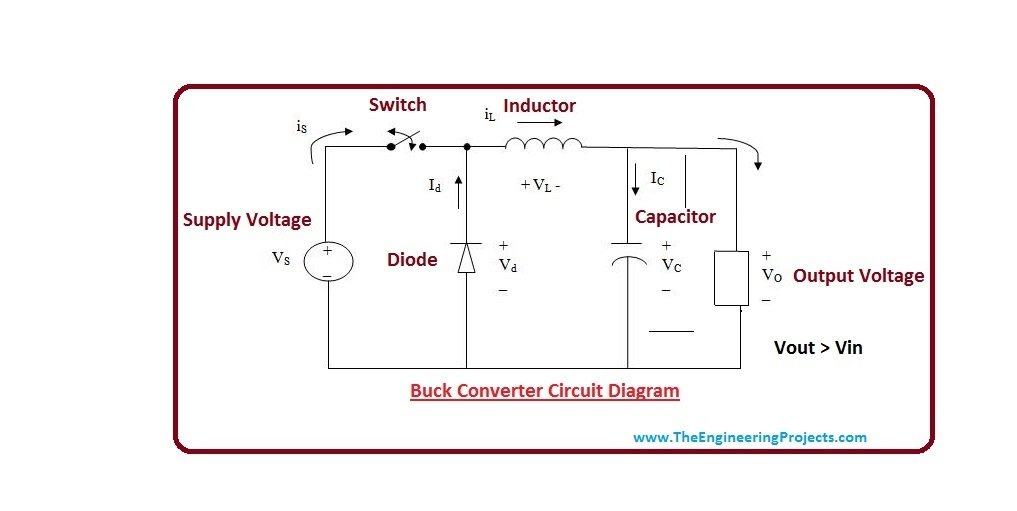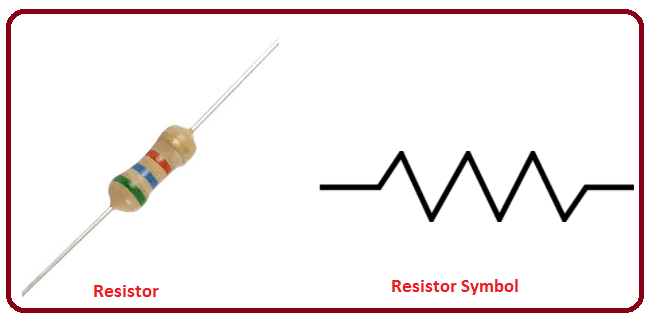

Introduction to Resistors


Introduction to Resistors
- A resistor is a two-terminal device that is used to resist the flow of current. It is one of the most commonly used components in electrical circuits.
- Resistance of any resister is described in ohms. Ohm is denoted by the Greek letter omega. Each resister has a different value of resistance which tells us how strongly it resists the flow of current. More the value of resistance more is the capability of resisting the current.
- Resistance will be considered as one ohm if the potential difference between the two ends of the conductor is 1 V and a current flowing through it is 1 Ampere.
- Resistance can be derived from Ohm's law which indicates voltage is directly proportional to the current flowing through the conductor.
V= I * R
- Each resistor comes with two wires, also called as leads. Between these two leads there lies a ceramic part which actually resists the flow of current. Resistor consists of three colored strips that indicate the value of resistance.
- Some resistors come with four colored strips. In such case, fourth strip indicates the value of tolerance. Tolerance is the value of the deviation of resistance from its given value on the resistor. Gold color of forth strip indicates tolerance is 5% and silver color indicates tolerance is 10%. Where there is no forth strip, tolerance is considered as 20%. Suppose, if resistance has 50-ohm resistance with no forth strip. Then tolerance of such resistor can be 50 ±20%.
- Resistance of any resistor also depends on its resistivity, its length and cross-sectional area.
- Resistors also indicate temperature coefficient. Temperature coefficient is known as a resistance due to the change in temperature. There are two types of temperature coefficients. Positive temperature coefficient and negative temperature coefficient. If resistance increases with the increase in temperature then it is called positive temperature coefficient and if resistance decreases with the decrease in temperature then it is called negative temperature coefficient.

How to Limit Current using Resistance
- Main purpose of resistance is to limit the current flowing through the component.
- Suppose, if we want to connect the LED with the direct DC source i.e. Battery, then it will burn out right away the moment you connect the LED with the battery.
- Because battery will allow a large amount of current to flow through the LED which will burn it out.
- LED can be avoided from any severe damage if we put the resistor between the battery and LED. It will control the amount of current flowing through the LED.
- Value of resistance you use depends on the current rating of the battery. You need to use the resistor with high resistance if current rating of a battery is high.
- We can calculate the resistance by using Ohm's Law. Suppose we have LED that comes with voltage rating of 12 voltage and current rating of 100mA or 0.1 A. From Ohm's Law
V=IR
R= V/I
R=12/0.1= 120 O
- In order to avoid LED from damaging we need resistor with resistance of 120 O
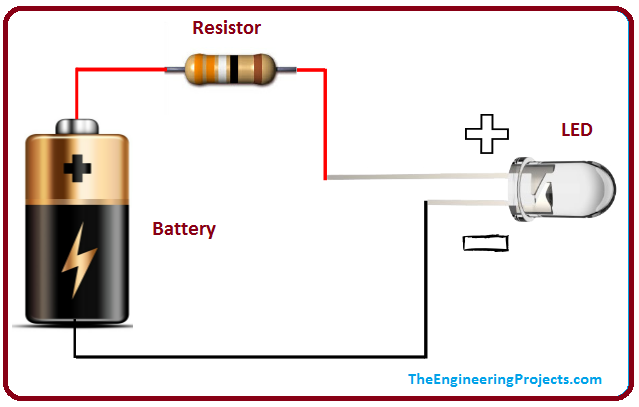
Combination of Resistors
Resistors can also be used in combination. There are classified into two types according to their combination.Resistors in Parallel
- If resistors are connected parallel to each other, then total resistance will be equal to the sum of reciprocal of all resistance.
1/R= 1/R1+1/R2+1/R3............1/Rn
Resistors in Series
- If resistors are connected in series, the total resistance will be equal to the sum of all resistance.
R= R1+R2+R3+R4..........Rn
Power Dissipation
- The power consumed by any resistor at any moment is defined as
- P= VI= V(V/R)= V²/R
- Most of the resistors are classified on their ability of power dissipation. Resistors who dissipate a large amount of energy are called as power resistors and are mostly used in power supplies, power amplifiers, and power conversion circuits.
- Power resistors are physically larger than normal resistors and their value cannot be directly identified by the reading color strip method.
- Resistors pertain to severe damage if their average power dissipation is greater than thier power rating. It results in permanently alternating the resistance.
- Excessive power dissipation can also damage the whole circuit. In order to avoid burning of the circuit, flameproof resistors are used that suddenly open the circuit before power dissipation gets too high.
How to Calculate Resistance of any Resistor
There are two different ways to calculate the resistance:Reading the Color Bands
- First method to calculate the resistance is by reading the color bands of the resistor.
- Each strip of color on the resistor represents a specific digit.
- Different colors corresponding to their digit values are given below.

- In the above figure, the first strip is brown and corresponding digit to brown is 1.
- The second strip is black, and the corresponding digit to black is 0.
- The third strip is orange and the corresponding digit to orange is three which actually shows the number of zeros.
- Forth strip is made of gold which indicates tolerance is ±5%.
- So overall resistance of this resistor is 10,000±5 % ohm.
Using a Multimeter
- Second method to measure the resistance is by using the multimeter as an ohmmeter. Mainly multimeter performs three functions. It is used to measure current voltage and resistance.
- Put the black probe on the COM port of multimeter. And put the red probe into the VOmA.
- You can measure the resistance of any resistor by holding the resistor with the two separate probes of the multimeter. Before calculating the resistance, you need to set the dial to ohm which is denoted on the multimeter by the symbol O.
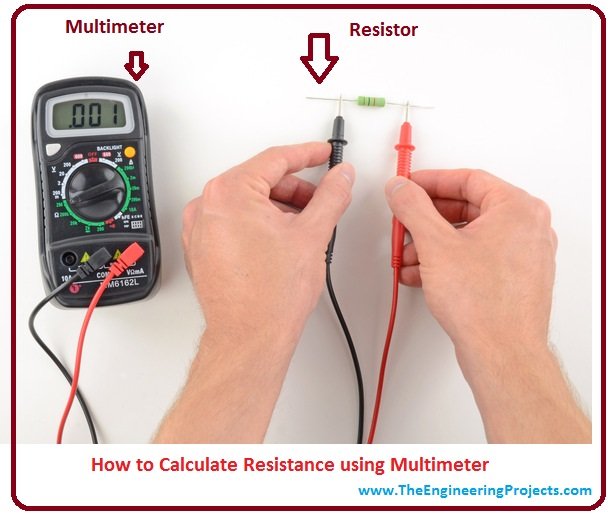
Types of Resistors
Resistors come in different forms, sizes, and shapes. Resistors are used in different applications depending on the current rating voltage and resistance. Let's discuss resistor types and their applications. Resistors are mainly classified into two types:- Linear Resistors
- Non-Linear Resistors
1. Linear Resistors
- Resistors are termed as linear resistors where current is directly proportional to the applied voltage.
- Resistance of these resistors changes with the change in temperature and voltage.
- In order words, resistors which follow Ohm's law are linear resistors.
- Linear resistors are further classified into two types
- Fixed Resistors
- Variable Resistors
- Carbon composition resistors comprise of rigid resisting element incorporated with lead wire. The resistor body is covered with plastic or paint.
- The resistive element at the mid of the lead wires contains fine carbon and insulating material which is usually ceramic. The resistance of such resistors is measured as the ratio of ceramic to carbon.
- Resistance value widely depends on the concentration of carbon value. More is the concentration of carbon, lesser will be the resistance.
- Carbon composition resisters come with poor stability and 5% tolerance.
- These resistors are become obsolete because of their high price but still they are used in wielding controls and power supplies.
- Resistance of such resistors varies from few ohms to 22 mega-ohms.

- A carbon pile resistor consists of layers of carbon discs that are placed between two metal plates.
- Resistance between the plates can be changed by changing the clamping pressure.
- These resistors are widely used in radio transmitters.
- A carbon pile resistor can also be used in generators, where it adjusts the current to keep the voltage in certain state.
- A carbon film resistor consists of amorphous carbon which provides relatively large resistance.
- These resistors encompass low noise as compared to carbon composition resistor.
- A carbon film resistor comes with a power rating that ranges between 0.125 to 5 W with resistance 1 ohm to 10 mega-ohm. These resistors are used in areas where high stability is required.
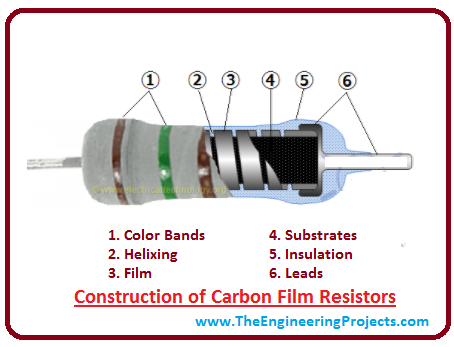
- Thick film resistors come in the shape of SMD(Surface mount device).
- Both, think and thin film resistors are manufactured in a same way but main difference is the resistive element that is used in thick film resisters is relatively very large than used in thin films.
- Thin film resistor consists of ceramic rod and resistive material.
- A very thin layer of conducting material is being placed on the insulating rod that is made of glass or ceramic material. This method of making thin film is called vacuum deposition.
- When thin film resistor is manufactured, it doesn't give an accurate value of resistance.
- Resistance value can be made accurate by the process called laser trimming.
- These resistors come in the tolerance range that lies between 1% to 5% and encompass much less noise level than thick film resistors.
- Compared to thick film resistors, thin film resistors are highly expensive.
- Wire wound resistors are widely used in many electrical applications. They are manufactured by winding a metal wire around fibreglass core or ceramic material. Whole assembly is being formed where two ends of wire are welded with rings and are covered with high layer of molded plastic or paint.
- These resistors have capability to bear high temperature upto 450 ºC.
- As wire wound resistors are same like coil so they inherit high value of inductance as compared to other resistors.
- Both, carbon composition resistors and wire wound resistors are used in same application except where high frequency is required. High frequency response of carbon composition resistors is better than wire wound resistors.
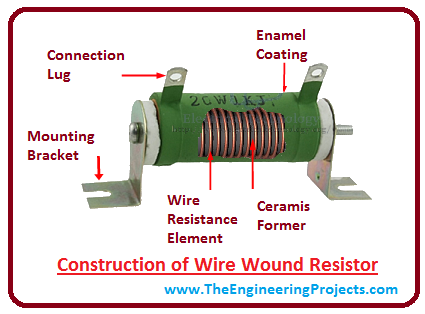
- Resistors are termed as variable resistors whose values can be adjusted manually by screw, knob, or dial.
- These resistors come with sliding arm that is attached to the shaft.
- Resistance value can be changed by rotating the sliding arm.
- They are mainly divided into two types:
- Rheostats
- Potentiometer
- Rheostat resistors are also known as variable wound resistors or tapped resistors.
- Rheostat is a manual operated three terminal device which is mainly used to restrict the current value.
- In order to make rheostat, Nichrome resistance is being wound around a ceramic core, then they are placed in a covered shell.

- A potentiometer is a three terminal device that consists of tapping points that are adjusted by a rotation of shaft.
- It can be used to provide a potential difference between the two terminal connected to the tapping points.
- They are widely used for volume control in many radio receivers.
- Potentially there is no difference between rheostat and potentiometer, however, both are used for difference purpose.
- Rheostat is used for controlling the level of current in the circuit while potentiometer is used for controlling the voltage in the circuit.

2. Non-Linear Resistors
- Resistors are termed as non-linear resistors where they do not pertain to follow ohm's law but their value of resistances changes with the slight change in temperature or current.
- Non-linear resistors are further divided into two types:
- Thermisters
- Varisters
- Resisters are termed as thermisters, if current flowing through it changes with the change in temperature.
- Thermister is basically a two terminal device which uses variable resister and indicates even a slight change in temperature.
- In thermister, resistance and temperature are inversely proportional to each other.
- Resisters are termed as varisters if current flowing through it changes with the change in applied voltage.
- These resistors are sensitive to voltage and avoid the circuits from getting high voltage spikes.
- They are used to maintain the voltage to a required level.
Applications of Resistors
Resisters are widely used in many electrical circuits. Following are the main applications of resistors.- They are used to limit current in order to avoid short circuit
- They are used to control voltage in order to avoid high spikes at the end of out put voltage
- Used in many electronic industries
- Temperature can also be controlled using these resistors
- In home electronic appliances like heater and iron
×
![]()








 1 user
1 user






 Continue Wishlist
Continue Wishlist





 Getting Started Guide
Getting Started Guide
 Help Center
Help Center
 Contact us
Contact us
 Doist Blog
Doist Blog
 Privacy
Privacy
 Security
Security
 Terms of Service
Terms of Service
 What's new: Channel Descriptions
What's new: Channel Descriptions





 Electronic Components
Electronic Components adnanaqeel
adnanaqeel 0 Comments
0 Comments








 2.3k
2.3k
 953
953
 921
921
 2.1K
2.1K
 Introduction to resistors
intro to resistors
resistors basics
working of resistors
resistors principle
Introduction to resistors
intro to resistors
resistors basics
working of resistors
resistors principle
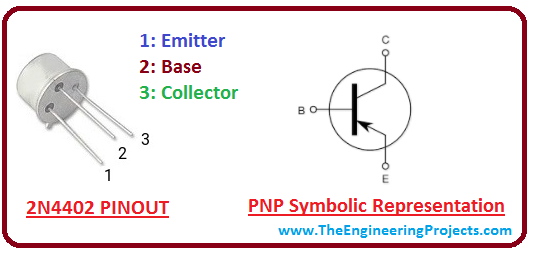
 Wednesday, January 24, 2018
Wednesday, January 24, 2018